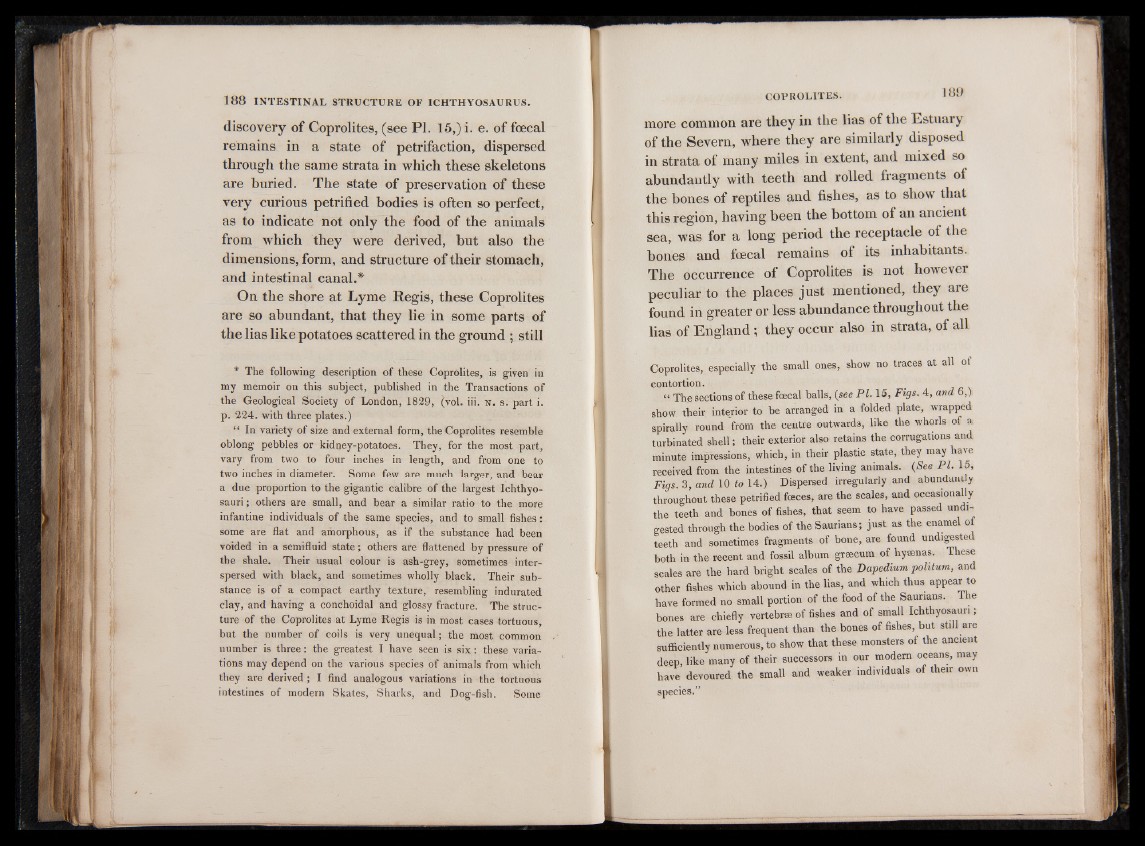
discovery of Coprolites, (see PI. 15,) i. e. of foecal
remains in a state of petrifaction, dispersed
through the same strata in which these skeletons
are buried. The state of preservation of these
very curious petrified bodies is often so perfect,
as to indicate not only the food of the animals
from which they were derived, but also the
dimensions, form, and structure of their stomach,
and intestinal canal.*
On the shore at Lyme Regis, these Coprolites
are so abundant, that they lie in some parts of
the lias like potatoes scattered in the ground ; still
* The following description of these Coprolites, is given in
my memoir on this subject, published in the Transactions of
the Geological Society of London, 1829, (vol. iii. n . s . part i.
p. 224. with three plates.)
“ In variety of size and external form, the Coprolites resemble
oblong pebbles or kidney-potatoes. They, for the most part,
vary from two to four inches in length, and from one to
two inches in diameter. Some few are much larger, and bear
a due proportion to the gigantic calibre of the largest Ichthyosauri
; others are small, and bear a similar ratio to the more
infantine individuals of the same species, and to small fishes:
some are flat and amorphous, as if the substance had been
voided in a semifluid state; others are flattened by pressure of
the shale. Their usual colour is ash-grey, sometimes interspersed
with black, and sometimes wholly black. Their substance
is of a compact earthy texture, resembling indurated
clay, and having a conchoidal and glossy fracture. The structure
of the Coprolites at Lyme Regis is in most cases tortuous,
but the number of coils is very unequal; the most common
number is three: the greatest I have seen is s ix : these variations
may depend on the various species of animals from which
they are derived; I find analogous variations in the tortuous
intestines of modern Skates, Sharks, and Dog-fish. Some
more common are they in the lias of the Estuary
of the Severn, where they are similarly disposed
in strata of many miles in extent, and mixed so
abundantly with teeth and rolled fragments of
the bones of reptiles and fishes, as to show that
this region, having been the bottom of an ancient
sea, was for a long period the receptacle of the
bones and foecal remains of its inhabitants.
The occurrence of Coprolites is not however
peculiar to the places just mentioned, they are
found in greater or less abundance throughout the
lias of England; they occur also in strata, of all
Coprolites, especially the small ones, show no traces at all of
contortion.
“ The sections of these foecal balls, (see Pl. 15, Figs. 4, and 6,)
show their interior to be arranged in a folded plate, wrapped
spirally round from the centre outwards, like the whorls of a
turbinated shell; their exterior also retains the corrugations and
minute impressions, which, in their plastic state, they may have
received from the intestines of the living animals. (See PL 15,
Figs. 3, and 10 to 14.) Dispersed irregularly and abundantly
throughout these petrified foeces, are the scales, and occasionally
the teeth and bones of fishes, that seem to have passed undigested
through the bodies of the Saurians; just as the enamel of
teeth and sometimes fragments of bone, are found undigested
both in the recent and fossil album grsecum of hyeenas. These
scales are the hard bright scales of the Dapedium politurn, and
other fishes which abound in the lias, and which thus appear to
have formed no small portion of the food of the Saurians. The
bones are chiefly vertebne of fishes and of small Ichthyosauri;
the latter are less frequent than the bones of fishes, but still are
sufficiently numerous, to show that these monsters of the ancient
deep, like many of their successors in our modern oceans, may
have devoured the small and weaker individuals of their own
species.”